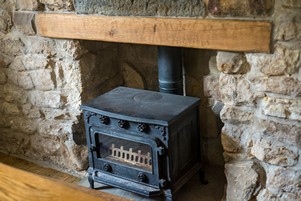
26 Nov 2019 What is a lintel and why do you need one?
The lintel is a horizontal beam placed across the fireplace opening to support the chimney. Sometimes you might see an arch in place of the lintel, which does the same job. Lintels are more common than arches because they are easy to construct and install.
Why you need a lintel
You should always have a lintel above your fireplace to support the weight of the chimney. In most properties the lintel will be made of a non-combustible material such as concrete, slate or granite, but in some cases it will be wooden.
Advantages of lintel
Lintels have the following advantages:
- They have a clean, simple look.
- They are easy to build and install.
- They are easy to centre.
- They can bear a heavy load.
Types of lintel
These are the most common types of lintel:
Wooden lintels
Wooden or timber lintels are the oldest types of lintel, and were common in earlier times. These days, more modern materials are typically preferred. Compared to modern materials, wooden lintels are more costly, structurally weaker, and more vulnerable to fire. They are also prone to decay if not properly ventilated.
For larger openings, the lintel may be constructed from two or more pieces of timber. Sometimes mild steel plates are used to strengthen the tops and bottoms of the lintel.
Stone lintels
Rectangular pieces of stone can be carved to form a lintel. The lintel can be constructed from one piece of stone or a number of pieces. The thickness of the lintel is typically 10 cm per meter of width. Stone is very firm and strong, but it is very heavy, and has a weak tensile nature meaning it is vulnerable to cracks as the structure is subjected to vibration.
Brick lintels
Brick lintels can be used when the opening is less than 1m and the load is relatively light. The depth of the brick lintel can vary from 10 cm to 20 cm. Bricks with ‘frogs’ that give an extra recess for the mortar, resulting in a stronger bond, are preferred to normal bricks.
For heavier loads, brick lintels can be reinforced with the insertion of horizontal mild steel bars and vertical stirrups 6 mm in diameter.
Steel lintels
Steel lintels are used for large openings and heavy loads. They are constructed from rolled steel joists or channel sections, either used as a single section or a combination of two or three sections.
When used singly, the steel joist is embedded in concrete or cladded with stone facing. Where there are more than one sections, tube separators are used to keep the sections in position.
Concrete lintels
Lintels made from reinforced concrete are very strong and have great rigidity, fire resistance and ease of construction. They can handle any load and any span. Their thickness is typically 8 cm per meter of width. They come in two main types: precast lintels and cast in situ lintels.
Fitting a new lintel
When fitting a new lintel, keep the following in mind:
- The bearing of the lintel is the length of each end of the beam that rests on the existing brickwork. It is important that there is sufficient bearing on each side to ensure the lintel does not deflect under the load it’s supporting.
- It is also vital to ensure the lintel is of sufficient height to accommodate the hearth thickness plus the height of the stove.
- If the existing lintel is too high, a new lintel can be fitted underneath the existing one.
We would always recommend that you seek the services of a qualified professional when fitting a new lintel.
If you have any questions about lintels or need advice about installing a new fireplace or stove, talk to our friendly team at Fiveways Fires & Stoves. We’re here to help, so get in touch by phone on 020 8127 4747 or by email at .


